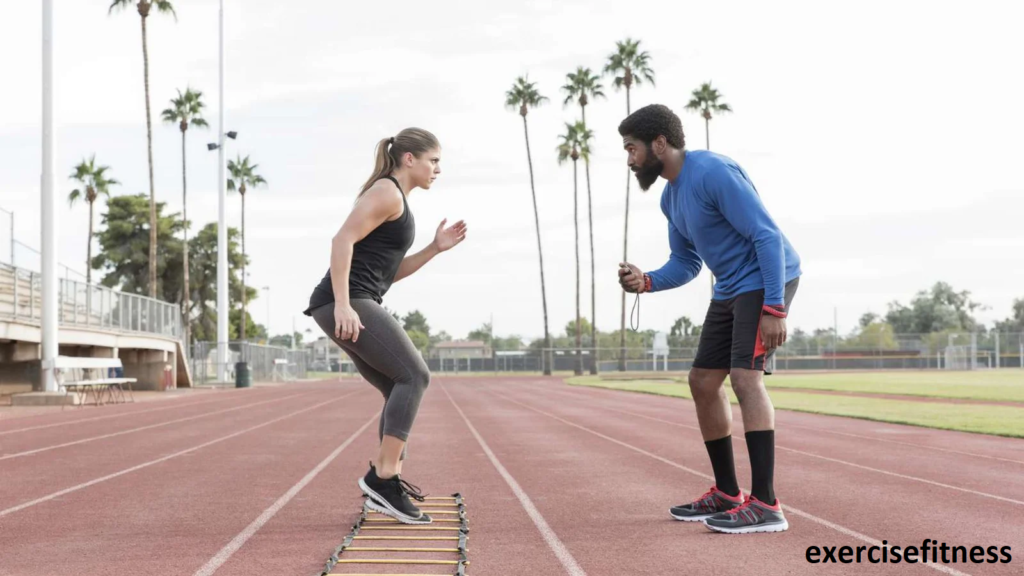Introduction:

Agility is key for athletes to move fast, change direction, and react quickly. It’s important in many sports like soccer, basketball, tennis, and martial arts. This article will look at why agility is important, how it boosts performance, and ways to get better at it.
1. What is Agility?
Agility means moving fast and keeping control and balance. It includes several parts:
- Speed: Moving quickly over distance.
- Coordination: Moving different body parts together smoothly.
- Balance: Staying stable while moving.
- Reaction Time: Quick responses to things happening around you.
2. Why is Agility Important in Sports?
Agility is crucial for both solo and team sports. It helps athletes do important actions well. Here’s why agility is so important:
A. Enhanced Performance
- Quick Direction Changes: Sports need quick turns, like in football or basketball.
- Acceleration and Deceleration: Being fast to start or stop is key to staying competitive.
- Improved Movement Efficiency: Agility saves energy, letting athletes perform better for longer.
B. Injury Prevention
- Better Body Control: Agility makes it easier to stay stable, lowering the risk of falls.
- Stronger Joints: Agility training strengthens muscles, protecting joints from injury.
C. Competitive Edge
- In many sports, small differences can make a big difference. Agility lets athletes outmaneuver opponents and react to surprises, giving them an edge.
D. Mental Sharpness
- Agility training boosts quick thinking, helping athletes make fast decisions during games.
3. Examples of Sports Requiring Agility
Agility is vital in many sports, including:
- Soccer: Quick changes in direction to get past defenders and catch the ball.
- Basketball: Dodging opponents and making fast cuts during plays.
- Tennis: Fast side-to-side movements to reach shots.
- Martial Arts: Quick reactions to opponents’ moves and effective counterattacks.
- Ice Hockey: Moving on skates while keeping control of the puck.
4. Components of Agility Training
Agility training works on several physical and mental skills:
A. Speed and Acceleration
- Drills like sprinting and resisted sprints help athletes reach top speed fast.
B. Dynamic Balance
- Exercises like single-leg hops and balance board drills improve stability during movement.
C. Reaction Time
- Reaction drills with visual or auditory cues enhance quick responses.
D. Coordination
- Activities like ladder drills or cone drills help develop precise movements.
E. Strength and Power
- Plyometric exercises, such as box jumps or depth jumps, build explosive power for quick movements.
5. Agility Drills and Exercises
Adding agility exercises to your training is key for better performance. Here are some effective drills:
A. Cone Drills
- Description: Use cones in patterns like zigzag or T-shape. Practice fast movements through them.
- Benefits: Boosts your ability to change direction and move precisely.
B. Ladder Drills
- Description: Run through an agility ladder with quick steps. Try patterns like high knees or lateral shuffles.
- Benefits: Increases foot speed, coordination, and rhythm.
C. Reactive Drills
- Description: A partner or coach will signal you to move in a certain direction. This simulates game unpredictability.
- Benefits: Improves your reaction time and decision-making.
D. Plyometric Drills
- Description: Do box jumps, lateral bounds, and single-leg hops.
- Benefits: Enhances explosive power and stability.
6. How to Measure and Assess Agility
Tracking your agility progress helps tailor training. Common tests include:
A. T-Test
- Description: Sprint and shuffle through a T-shaped pattern.
- Purpose: Measures speed, direction changes, and lateral movement.
B. Illinois Agility Test
- Description: Navigate a zigzag pattern of cones.
- Purpose: Evaluates agility, balance, and quickness.
C. 5-10-5 Shuttle Run
- Description: Sprint five yards, return, then sprint ten yards and back.
- Purpose: Assesses acceleration, deceleration, and direction changes.
7. Improving Agility: Best Practices
A. Consistency
- Make agility drills a regular part of your training to see improvement.
B. Progressive Overload
- As you get better, increase the complexity, speed, or duration of drills.
C. Focus on Form
- Good technique makes movements efficient and reduces injury risk.
D. Incorporate Sport-Specific Drills
- Customize agility exercises to match your sport’s movements.
Conclusion:
Agility is key for athletic performance, affecting how well you react, move, and execute plays. Agility training boosts physical skills, prevents injuries, and gives a competitive edge. Whether you’re a pro or just starting, focusing on agility will improve your sport performance.
